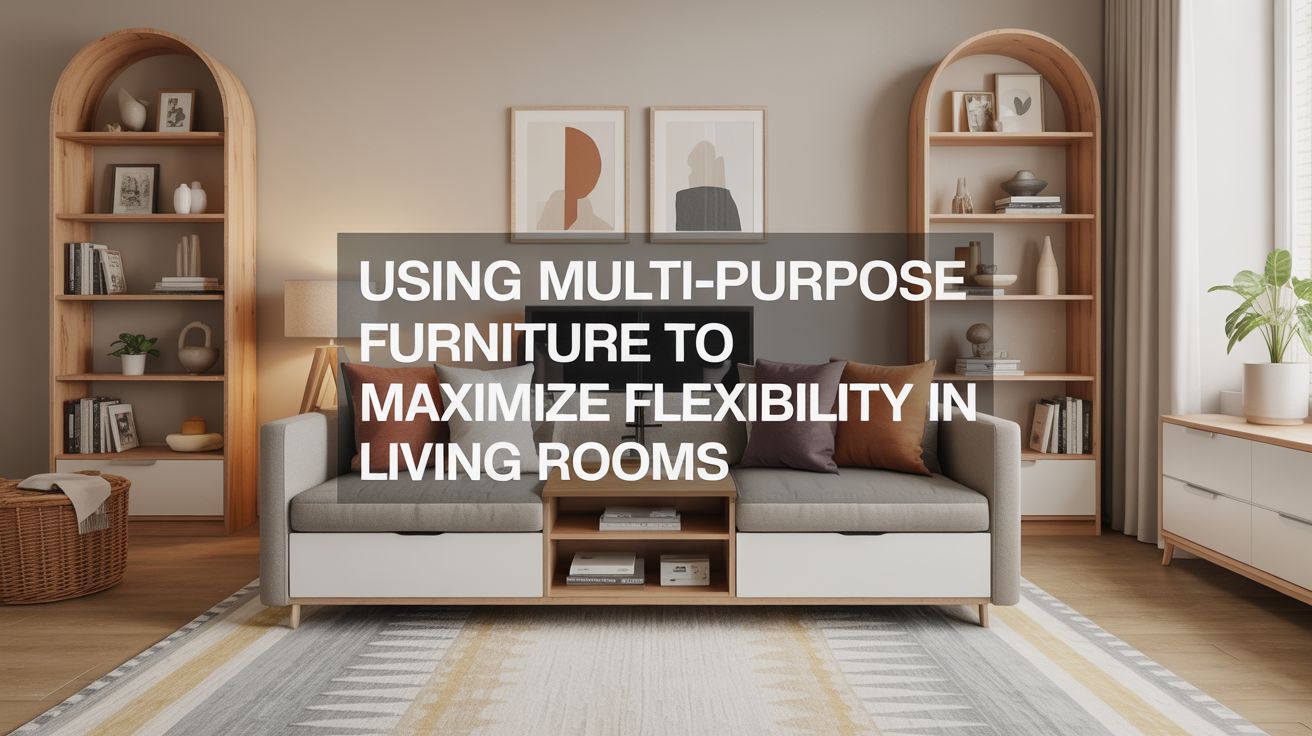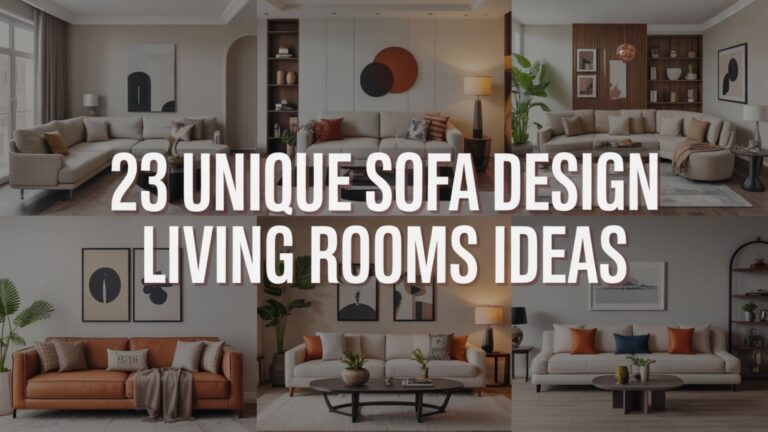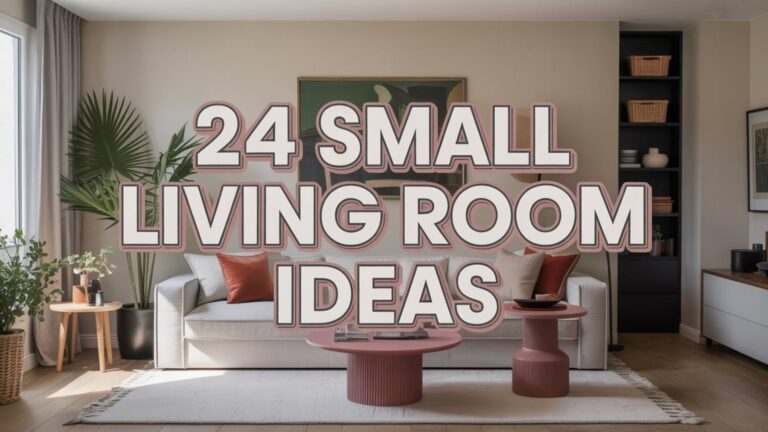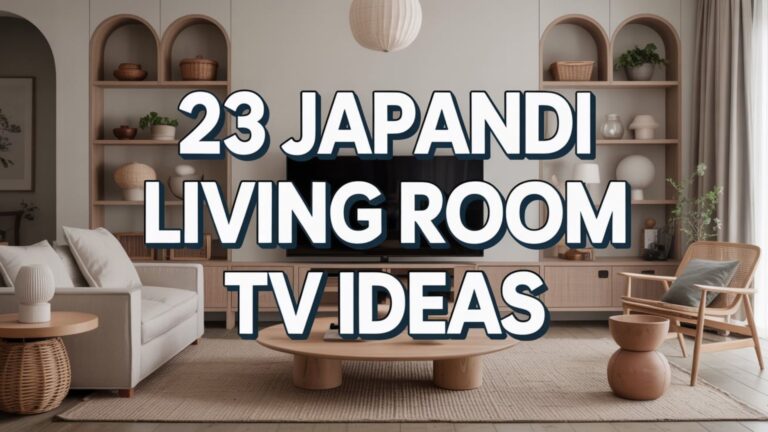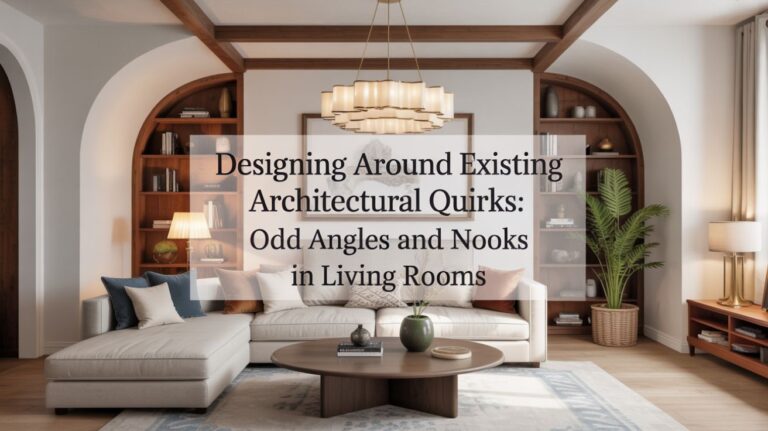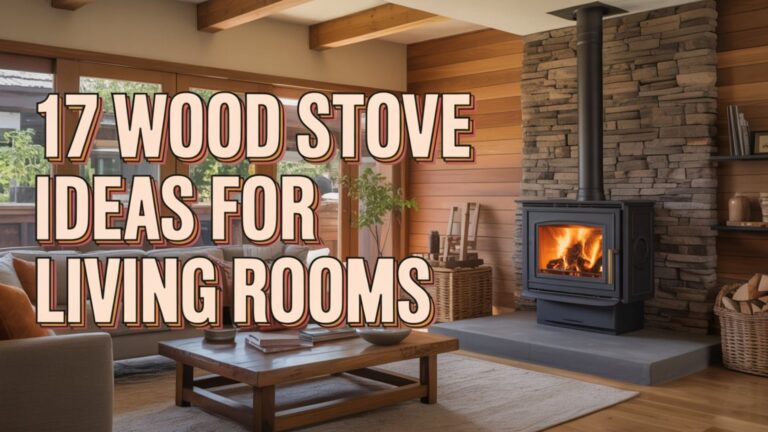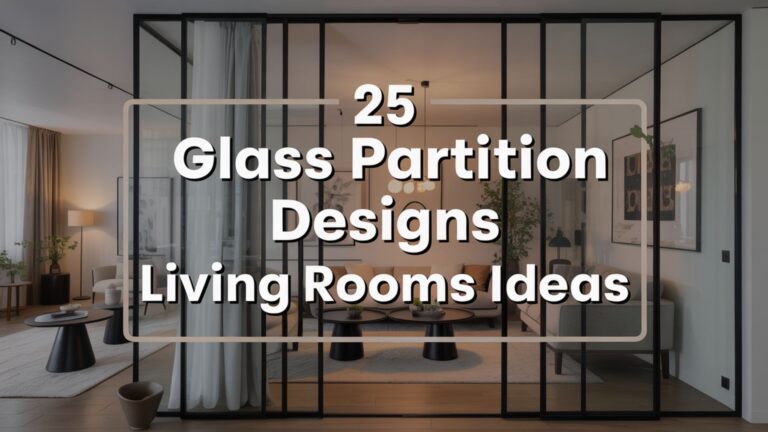Using Multi-Purpose Furniture to Maximize Flexibility in Living Rooms
I have been, or can be if you click on a link and make a purchase, compensated via a cash payment, gift, or something else of value for writing this post. As an Amazon Associate, I earn from qualifying purchases. Please read my full Affiliate Disclosure for more information.
Flexible living rooms start with multi‑purpose pieces that pull double duty. You’ll gain room to breathe by choosing modular sofas that become guest beds, nesting tables that morph from coffee to dining surfaces, and ottomans with hidden storage to tame clutter. Pair slim consoles with shelves to anchor zones without crowding them. Place foldable tables and stacking units for instant reconfigurations, then unify with a cohesive color palette. Curate thoughtfully, and you’ll master space—more tips await beyond this.
Key Takeaways
- Start with modular, space-saving pieces to create a flexible foundation for rearranging activities.
- Use nesting tables and fold-away surfaces to transform coffee areas into work or dining spaces.
- Choose dual-purpose storage furniture (ottomans, benches) to combine seating, surface, and storage.
- Integrate sleeper or modular sofas to expand seating and sleeping options without clutter.
- Maintain a cohesive color palette and streamlined styling to keep spaces visually calm during transformations.
Benefits of Multi-Purpose Furniture in Small Living Rooms
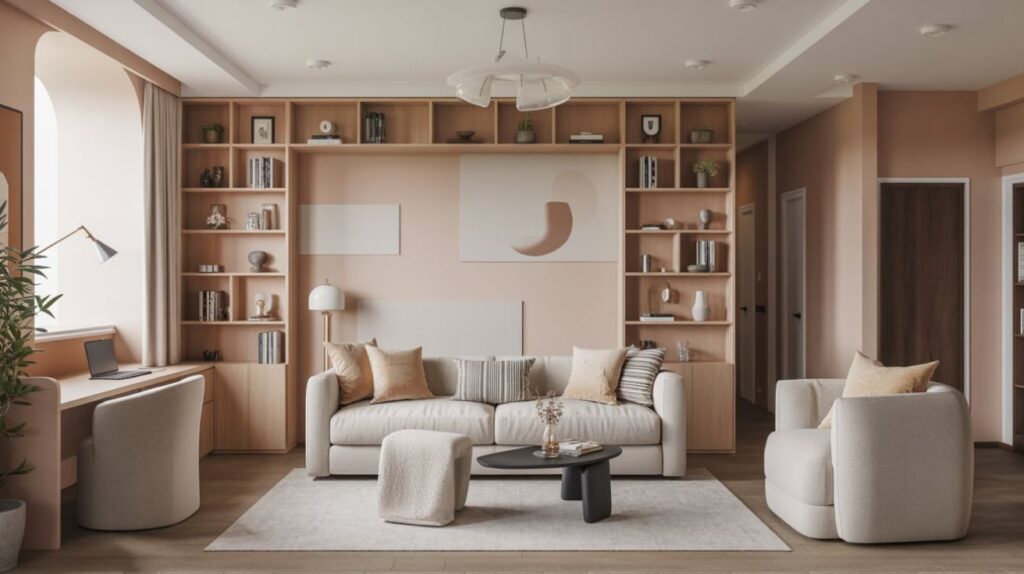
In small living rooms, multi-purpose furniture isn’t a gimmick; it’s a strategic move that frees up space without sacrificing style. You gain practical layouts that adapt to crowds, work, and unwind moments. Benefits include reduced clutter, faster cleaning, and calmer aesthetics, since fewer pieces carry more function. Every choice becomes intentional: a sofa bed for guests, an ottoman with storage, a coffee table that rises to dining height. You’ll also notice decorative accents aligning with a cohesive theme, and lighting solutions that heighten ambiance without adding bulk. Practical, scalable design helps you reclaim floor area and comfort alike.
Smart Layering: Nested Tables and Convertible Surfaces
You’ll explore how nested tables layer function with form, turning compact footprints into flexible surfaces. Consider the roles each surface can play—from side table to tray to desk—and how that adaptability shapes your layout. We’ll map clear, practical layering strategies that maximize utility without clutter.
Nested Table Functions
Nested tables aren’t just extra surfaces—they’re a tactical layer that adapts on demand. You explore nested table functions as compact, modular tools that release flow without clutter. By pairing sizes and heights, you create purposeful steps for support, display, or temporary workspaces, shifting roles as your room evolves. Each piece contributes to multi layered storage, storing essentials within reach while preserving clean sightlines. You’ll appreciate the overlap: drawers, shelves, and trays nest within one another, so you gain surface versatility plus hidden capacity. This smart layering keeps spaces calm, organized, and ready for anything—without sacrificing style or accessibility.
Convertible Surface Roles
Convertible Surface Roles: smart layering lets surfaces morph on demand, so your coffee table can become a drafting board, a dining nook, or a spill-ready tray without extra gear. You glide between tasks with simple moves, keeping momentum intact. Hidden storage hides beneath or inside the unit, preserving a clean surface while you switch roles. When you need a workstation, a quick lift reveals a larger plane; for meals, collapse to a seating-friendly height. This approach boosts aesthetic appeal and minimizes clutter, so your space stays calm, purposeful, and adaptable to changing moments. Clarity, efficiency, flexibility—delivered.
Flexible Layering Strategies
From smart layering to nested surfaces, Flexible Layering Strategies tighten the weave between form and function. You’ll combine smart tables that tuck under one another with adjustable surfaces, so each piece serves multiple roles without clutter. Think nested tables that slide out for coffee, study, or display, then conceal when unused. Use color schemes to unify varied heights and materials, and leverage lighting techniques to highlight shifts and depth. Pair a slim console with a shallow top to anchor seating areas, then slide a mid-rail shelf into place for extra storage. Precision planning keeps spaces breathable, adaptable, and visually coherent.
Storage-Driven Solutions: Ottomans, Benches, and Shelves
Storage-driven solutions turn everyday pieces into smart, space-saving allies. You’ll use ottomans with hidden storage to corral clutter, benches that double as coffee tables, and shelves that organize by zone. Think modularity: stack, slide, or nest to reconfigure layouts without sacrificing flow. Choose decorative accents and color coordination to keep visuals cohesive while you gain function. Ottomans invite tactile comfort; benches offer seating plus surface area; shelves organize books, tech, and toys with accessible display. Prioritize sturdiness and accessibility so each piece serves daily needs, seasons, and guests, without creating visual noise. Your living room stays calm, versatile, and purposeful.
Flexible Seating Arrangements for Guests and Daily Use
A flexible living room starts with seating that adapts to how you live, from daily lounging to occasional hosting. You’ll want options that are easy to move, stack, or reconfigure, so guests and family can settle in comfortably any time. Think modular pieces, tucked-away stools, and chairs that double as surfaces to keep conversations flowing without clutter.
Flexible Seating Options
Flexible seating isn’t just about extra chairs; it’s about shaping conversations and daily routines so conversations flow as freely as possible. You design zones that invite interaction, using varied scales and textures to cue comfort and focus. Flexible seating supports quick reconfigurations for hobbies, work, or play, while still honoring artistic expression and outdoor furniture aesthetics. When you choose options, aim for accessibility, legibility, and balance—so guests feel invited, not overwhelmed. This approach blends strategy with warmth, turning every gathering into a streamlined, meaningful exchange.
- Moveable stools create instant groupings
- Floor cushions invite relaxed collaboration
- Slim benches extend seating without clutter
- Ottomans double as tables and hubs
- Multifunctional poufs adapt to spaces
Daily-Use Adaptability
You’ve already set the stage for flexible seating; now it’s about how that adaptability serves daily life and guests alike. With smart arrangement, you seat daily routines and surprise visitors without reconfiguring the room. Choose modular pieces that swap from cozy chat to quick workspace, then back to lounge, keeping traffic flow intuitive. Use decorative accents to cue different moods or zones, from calm reading corners to lively game nights. Let color schemes guide cohesion, so every seat feels purposeful, not wasted. Plan quick-access storage for blankets and peripherals, preserving neatness while inviting use and warmth.
Transformative Pieces: Sleeper Sofas and Modular Sofas
Sleeper sofas and modular sofas aren’t just furniture; they’re strategic moves for today’s living rooms, turning tight spaces into flexible layouts with one smart click or pull. You’ll feel how color coordination and material selection drive cohesion, even as the pieces transform. Each choice signals function: invite guests, carve quiet zones, or widen your floor plan in moments.
- Maximize seating without sacrificing flow
- Pair textures that endure daily use
- Choose neutral bases, bold accents
- Align cushions for easy reshaping
- Plan routines that adapt to gatherings
Creating Workspaces Without Cluttering the Room
A tidy work corner can emerge from a few smart choices that honor the room’s flow rather than fight it. You can carve out function with compact, modular setups that tuck against a wall or sofa arm, keeping pathways clear. Choose a desk that doubles as a side table, and use vertical surfaces for storage to avoid surface clutter. Integrate artistic wall displays to inspire focus without intruding on space, and opt for decorative lighting that doubles as ambient glow and task light. Keep cords hidden, switch to wireless tools, and rotate accessories seasonally to preserve calm, productive energy.
Styling Tips for Cohesion Across Modular Pieces
To pull modular pieces into a single, cohesive look, think in layers: base tones anchor the space, while texture and scale create harmony across every module.
- Align color coordination across sofas, tables, and storage to minimize visual noise
- Maintain material consistency—wood, metal, and fabric should feel related
- Create rhythm with repeating shapes and proportional gaps between pieces
- Introduce a unifying accent color in small doses for focal cohesion
- Balance glam and minimalism to avoid clutter while keeping depth and interest
This approach keeps your setup flexible yet deliberately styled.
Budget-Friendly Picks and Real-Life Setups
Budget-friendly doesn’t have to mean bland. You’ll discover smart, affordable picks that stretch space without shouting. Start with modular sofas that fold into guest beds, then add nesting tables you can slide apart for conversation or scale up for dining. Look for clean lines with subtle hardware—art deco hints or vintage charm—so you feel deliberate style, not thrift-store chaos. Real-life setups show three core tactics: maximize vertical storage, group dual-purpose pieces, and keep a cohesive color palette. Pair fabric trims with sturdy finishes for longevity. Your living room gains flexibility, personality, and budget-friendly polish in one cohesive plan.
Conclusion
You’ve got the blueprint: smart layers, hidden storage, and flexible seating that morphs with your days. Tie pieces together with a cohesive color story, and let convertible surfaces blur the line between work and play. When guests arrive, casual seating becomes intentional gathering space. Stay budget-smart, mix modular with sleeper options, and keep clutter at bay. In small rooms, adaptability is your superpower—design that breathes, fits, and travels with you.
